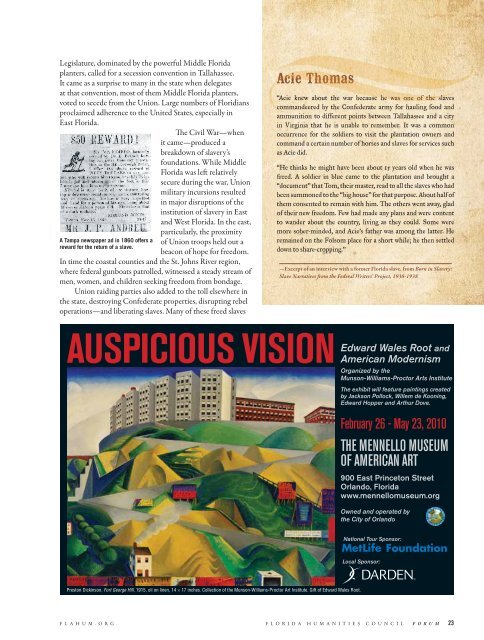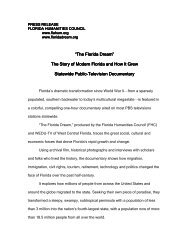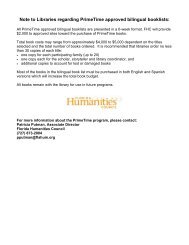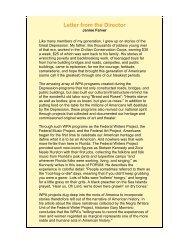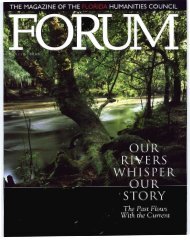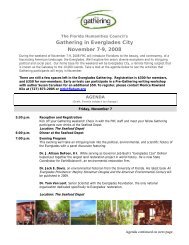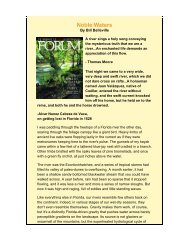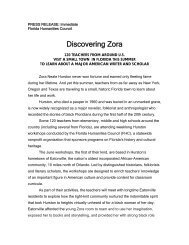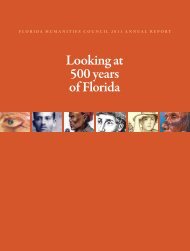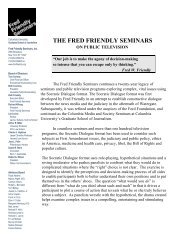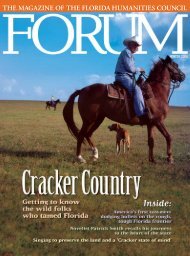when florida “Opened up the gates of hell” - Florida Humanities ...
when florida “Opened up the gates of hell” - Florida Humanities ...
when florida “Opened up the gates of hell” - Florida Humanities ...
Create successful ePaper yourself
Turn your PDF publications into a flip-book with our unique Google optimized e-Paper software.
Legislature, dominated by <strong>the</strong> powerful Middle <strong>Florida</strong><br />
planters, called for a secession convention in Tallahassee.<br />
It came as a surprise to many in <strong>the</strong> state <strong>when</strong> dele<strong>gates</strong><br />
at that convention, most <strong>of</strong> <strong>the</strong>m Middle <strong>Florida</strong> planters,<br />
voted to secede from <strong>the</strong> Union. Large numbers <strong>of</strong> Floridians<br />
proclaimed adherence to <strong>the</strong> United States, especially in<br />
East <strong>Florida</strong>.<br />
The Civil War—<strong>when</strong><br />
it came—produced a<br />
breakdown <strong>of</strong> slavery’s<br />
foundations. While Middle<br />
<strong>Florida</strong> was left relatively<br />
secure during <strong>the</strong> war, Union<br />
military incursions resulted<br />
in major disr<strong>up</strong>tions <strong>of</strong> <strong>the</strong><br />
institution <strong>of</strong> slavery in East<br />
and West <strong>Florida</strong>. In <strong>the</strong> east,<br />
A Tampa newspaper ad in 1860 <strong>of</strong>fers a<br />
reward for <strong>the</strong> return <strong>of</strong> a slave.<br />
AUSPICIOUS VISION Edward<br />
F L A H U M . O R G<br />
particularly, <strong>the</strong> proximity<br />
<strong>of</strong> Union troops held out a<br />
beacon <strong>of</strong> hope for freedom.<br />
In time <strong>the</strong> coastal counties and <strong>the</strong> St. Johns River region,<br />
where federal gunboats patrolled, witnessed a steady stream <strong>of</strong><br />
men, women, and children seeking freedom from bondage.<br />
Union raiding parties also added to <strong>the</strong> toll elsewhere in<br />
<strong>the</strong> state, destroying Confederate properties, disr<strong>up</strong>ting rebel<br />
operations—and liberating slaves. Many <strong>of</strong> <strong>the</strong>se freed slaves<br />
Acie Thomas<br />
Preston Dickinson, Fort George Hill, 1915, oil on linen, 14 × 17 inches. Collection <strong>of</strong> <strong>the</strong> Munson-Williams-Proctor Art Institute. Gift <strong>of</strong> Edward Wales Root.<br />
“Acie knew about <strong>the</strong> war because he was one <strong>of</strong> <strong>the</strong> slaves<br />
commandeered by <strong>the</strong> Confederate army for hauling food and<br />
ammunition to different points between Tallahassee and a city<br />
in Virginia that he is unable to remember. It was a common<br />
occurrence for <strong>the</strong> soldiers to visit <strong>the</strong> plantation owners and<br />
command a certain number <strong>of</strong> horses and slaves for services such<br />
as Acie did.<br />
“He thinks he might have been about 15 years old <strong>when</strong> he was<br />
freed. A soldier in blue came to <strong>the</strong> plantation and brought a<br />
“document” that Tom, <strong>the</strong>ir master, read to all <strong>the</strong> slaves who had<br />
been summoned to <strong>the</strong> “big house” for that purpose. About half <strong>of</strong><br />
<strong>the</strong>m consented to remain with him. The o<strong>the</strong>rs went away, glad<br />
<strong>of</strong> <strong>the</strong>ir new freedom. Few had made any plans and were content<br />
to wander about <strong>the</strong> country, living as <strong>the</strong>y could. Some were<br />
more sober-minded, and Acie’s fa<strong>the</strong>r was among <strong>the</strong> latter. He<br />
remained on <strong>the</strong> Folsom place for a short while; he <strong>the</strong>n settled<br />
down to share-cropping.”<br />
—Excerpt <strong>of</strong> an interview with a former <strong>Florida</strong> slave, from Born in Slavery:<br />
Slave Narratives from <strong>the</strong> Federal Writers’ Project, 1936-1938<br />
Wales Root and<br />
American Modernism<br />
Organized by <strong>the</strong><br />
Munson-Williams-Proctor Arts Institute<br />
The exhibit will feature paintings created<br />
by Jackson Pollock, Willem de Kooning,<br />
Edward Hopper and Arthur Dove.<br />
February 26 - May 23, 2010<br />
THE MENNELLO MUSEUM<br />
OF AMERICAN ART<br />
900 East Princeton Street<br />
Orlando, <strong>Florida</strong><br />
www.mennellomuseum.org<br />
Owned and operated by<br />
<strong>the</strong> City <strong>of</strong> Orlando<br />
National Tour Sponsor:<br />
Local Sponsor:<br />
Mennello Ad-Forum (12-11-09).indd 1 12/11/09 2:25:52 PM<br />
F L O R I D A H U M A N I T I E S C O U N C I L F O R U M 23


